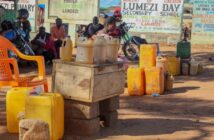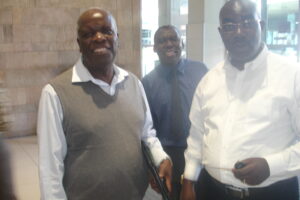
Hon. Ng’andu Peter Magande (left) with Party of National Unity and Progress (PNUP) Vice Presiden Kasote Singogo (right) at Manda Hill in Lusaka PICTURE by Derrick Sinjela
Personal Viewpoint by Ngándu Peter Magande
Zambia`s economy is going through a very difficulty period due to a huge national foreign debt burden of US $ 12.74 Billion and a domestic debt of K143.8 Billion (US $6.45 billion).
Domestic loans are made of unpaid money for goods and services acquired by the government from local suppliers. If you supplied excise books, medicines or fuel to a government department and you have not been paid, your money is in this billion debt.
This is reminiscent of the situation of 2000, when the country had an external debt of US$6.3 billion, which rose to US $7.2 billion by 2005.
Zambia’s economy declined by three percent in 2020 and the number of poor Zambians increased in tandem with a population growth of over three percent per year. While the population is generating more consumers, the goods and services to be shared among the citizens are decreasing, leading to prevalent stunting, while the national debt is increasing each day, leading to more poverty.
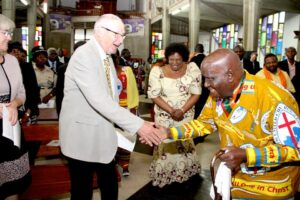
Acting President Dr Guy Scott welcomes former First Republican president Dr Kaunda on arrival the Anglican Cathedral of the Holy Cross for the Interdenominational Thanks-Giving Service for Peaceful Presidential Elections on Sunday 18th January, 2015 – Picture by THOMAS NSAMA.
In a speech delivered on Thursday 17th December 2020, President Edgar Lungu, when launching the Economic Recovery Programme (ERP) ( similar to Kaunda’s 1987 ERP), had stated that, “ It is worse for developing nations like ours, encumbered by huge debts, and whose economies were already struggling before Covid 19 came.
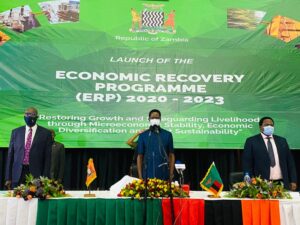
Thursday 17th December 2020, President Edgar Chagwa Lungu
Millions of our people are barely surviving, our economy is at the moment battered and stretched, the needs for our people are overwhelming and the resource envelope is thinning by the day”. What has to be done and by whom in order to solve these problems being encountered by the Zambians every day?
On Friday 14th May, 2021, the Cabinet was dissolved by President Lungu. The major benefit of the dissolution of the Cabinet at election time, to the Zambian citizens, is that the civil servants then assume the responsibilities of running the Zambian public administration.
Many senior civil servants are technically competent people, who end up being supervised by incompetent politicians, some appointed to positions on basis of political and tribal patronage without even an iota of patriotism.
I have decided to join the campaign to remind all those wishing to be in the leadership of Zambia in the next five years at councillor, mayor, member of parliament and president levels of the major issues affecting the Zambian citizens, which they should address to give hope to the Zambian electorates. The issues are the lack of adequate food, the huge government debt and the lack of wealth at both personal and national levels.
“It is necessary to introspect on what had previously worked and what had not in the implementation of past national development plans. We need to make attainable and realistic proposals for the 8NDP to work”, stated the Secretary to the Cabinet, the head of the public service.
This was during the official opening of the meeting of National Development Coordinating Committee (NDCC) of priority setting of the 8th National Development Plan (NDP).
Since 1971, when I joined the Zambian Government, I have been privileged to participate in the planning and implementation of five national development plans. Four were under President Kaunda and one, the Fifth National Development Plan and Vision 2030 were under President Mwanawasa.
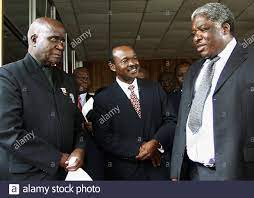
Former Zambian President Kaunda talks with COMESA Secretary General Mwencha and Zambian President Mwanawasa in Zambian capital Lusaka. Former Zambian President Kenneth Kaunda (L), Common Market for Eastern and Southern Africa (COMESA) Secretary General Erastus Mwencha (C) and Zambian President Levy Mwanawasa (R) talk as they attend the 10th anniversary of Africa’s main trading bloc, the 19-member Common Market for Eastern and Southern Africa, or Comesa December 8, 2004 in Zambian capital Lusaka. REUTERS/Salim Henry
I have decided to share some of my experiences on what has worked and what has not worked in the important sector of mining. Due to the huge expenditure and mismanagement of the Fertilizer Input Support Programme (FISP), I intend to give my experiences on farming also.
While Zambia is endowed with abundant natural resources, which include water, land and minerals such as copper, gold, platinum and emeralds, its people remain at the top of the poverty graph.
Mining, especially of copper and agriculture have been at the centre of Zambia’s development since Independence in 1964. These two sectors require special and intelligent management by Zambian Government leaders.
Since time in memorial, minerals in Zambia have belonged to the inhabitants of Zambia. However my ancestors could only engage in artisanal mining due to lack of appropriate equipment to undertake large scale mining. Large-scale mining was started, about a hundred years ago by foreigners.
The foreign investors brought into the country skills and appropriate equipment for digging and processing the minerals. Most the mining companies were subsidiary companies of larger companies that had operations in other parts of the world.
They were able to source the required equipment from their countries at relatively low prices. Some were even sister companies to buyers of the minerals produced in Zambia.
As mining was developing, it attracted commercial farming by foreigners along the line of rail from Livingstone to Chililabombwe and a little at Chipata.
The rich soils of Mkushi were surveyed, properly demarcated allocated to foreigners farmers who were assigned to produce food for the Copperbelt community.
Zambians have not experienced the biting famines as elsewhere, since the majority of Zambians grow their own food, although inefficiently.
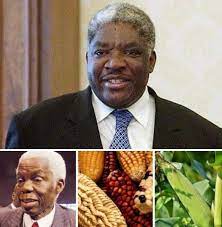
Mwanawasa and former Agriculture Minister Mundia Sikatana built agro sector
During the first ten years of independence, Zambia experienced rapid development due to the revenues from the high prices of copper. Until 1968, both the agricultural and mining sectors were in the hands of the private participants.
The nationalistic feeling of being marginalized in the sharing of mining revenues led the UNIP Zambian government to announce its intention to nationalize the mines in 1968, “in order for the Zambians to benefit from the God-given natural resource”.
This strong feeling of nationalism was not applied to land, as the best soils and farms, beside the railway line, were not nationalized. The foreign farmers were allowed to continue enjoying occupancy of our land on 99 years leases.
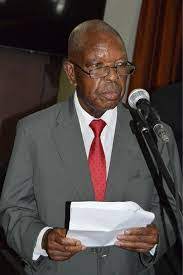
The late Francis Herbert Kaunda and Roan Consolidated Mines (RCM)
In the desire to achieve an orderly majority-shareholding in the mines, President Kaunda’s administration only acquired 51 percent shares in the mines in August 1970. Two companies, namely Nchanga Consolidated Copper Mines (NCCM) managed by Mr Francis Kaunda and Roan Consolidated Mines (RCM) under Mr David Phiri were created. The mining industry continued to operate efficiently and earned the foreign currency required for importation of equipment, other goods and services by the country.
In 1973, a record production of 750,000 tonnes was achieved. Copper became a determinant of the country’s development. Soon, the good performance of the economy was militated against by the rising oil prices and falling copper prices.
In the 1980’s, production of copper started going down for lack of well-serviced mining equipment due to limited foreign exchange. During this period, the government went out and borrowed substantial amounts to maintain a high level of consumption and investment in mostly import-substitution industries and social infrastructure.
In 1982, the Zambia Consolidated Copper Mines Limited (ZCCM) was established to superintend over all mining activities in the country. Even at that point, the Zambian Government held only 60 percent equity with Anglo American Corporation (ACC) holding 27 percent and 13 percent owned by private investors.
The drastic drop in copper prices in the late seventies led to the inability of the government to service the debts followed by a build up of foreign debt. In 1987, being unable to service the foreign debt, the government declared that it would pay only ten percent of the outstanding debt yearly.
The government broke away from the IMF, which had been one of faithful lenders. This dented the country’s reputation in the international financial community and led to the donor community and the multilateral institutions to withdraw financial support.
A new national development plan, which was produced in 1988 and dubbed, “Growth From Own Resources” did not work. The inability of the government to enhance domestic resource mobilisation resulted in a huge budget deficit and non-implementation of the plan.
Negotiations were initiated that led to a new agreement with the IMF and a return to the donor community for financial assistance. The new agreement included conditions to reduce government expenditure and to privatize some of the companies owned by the government.
The mining industry having suffered from low copper prices and a lack of adequate revenues to maintain the existing equipment could not revive and reach earlier high levels of production.
While the new MMD government that came into power in 1991 was in full support of wholesome privatisation, they held onto the mines due to the militant labour movement on the mines, which wanted to secure permanent employment of the workers. This did not work, as the deteriorating mining equipment could not produce adequate minerals.
The government took over the paying of the salaries to ZCCM workers and the maintenance of the mines. With much of the revenue going to debt service, the government could not afford to meet the huge bill and the privatisation of the mines commenced in 1996.
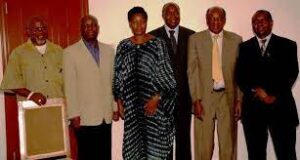
Zambia’s former Ministers of Finance Dr. Katele Kalumba, Magande,Edith Zewelani Nawakwi, Felix Chipota Mutati, Alexander Bwalya Chikwanda and Rabson Chongo
Nationalisation of the mining industry done in 1968 did not work to benefit the majority of Zambians. The independence and power of the management of ZCCM could not allow the revenues from the mining industry to be shared through the national budget. The Copperbelt was an enclave of well-paid and well-to-do Zambians. President Kaunda described the dual situation as ‘two nations in one”. Revenues from the nationalized mines were used for lavish consumption, such as imported goal posts for Mpelembe Secondary School, which admitted only children connected to ZCCM employees.
As part of the privatization strategy, the assets of ZCCM were unbundled into five units and sold off as separate new entities or business packages to the private sector. The reason for unbundling the ZCCM Limited into business packages was to promote diversity of ownership and minimise political and economic risks.
A new parastatal ZCCM-Investment Holdings (ZCCM-IH) was created to manage the minority shares of the Zambian Government in all the mining companies controlled and managed by the new investors. The long-term plan was to later sell these minority shares to the Zambian public and financial institutions.
Although the new administration of President Mwanawasa that took-over in 2001 accelerated the privatisation of the mines, production continued to fall as not much investments had been made by this time by the new mine owners.
Mining contribution to Zambia’s GDP had dropped to 7.9% in 2002 from 16.5% in 1994. The conducive Development Agreements negotiated between 1997 and 2000, with stability periods of as much as 20 years, were very attractive and resulted in significant inflow of new foreign investors.
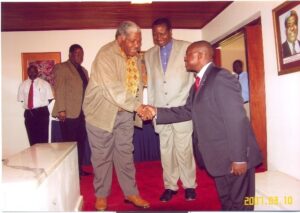
Dr. Chabuka Kawesha with President Levy Patrick Mwanawasa
The predicable Development Agreements aided by a skilled team of government officials under President Mwanawasa, lured private mining interests into the remote North Western Province . Equinox opened Lumwana Mine and First Quantum Minerals revamped the Kansanshi Mine, which had been abandoned by ZCCM near
Solwezi.
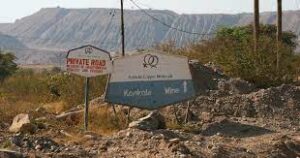
Konkola by Vedanta Resources Limited
A project to reach the richest copper ores in the depths of the Copperbelt was started at Konkola by Vedanta Resources Limited (VRL). Vedanta also constructed a state-of–the-art concentrator and a large smelter to accommodate the processing of additional imported concentrates from neighbouring Democratic Re[ublic of Congo (DRC).
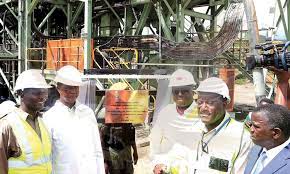
Munali Hills in the Southern Province was started by Albidon Limited PICTURE Courtesy of Zambia Daily Mail
A new mine to extract nickel and platinum from under the Munali Hills in the Southern Province was started by Albidon Limited, an Australian company. At that time, nickel was fetching US $50,000 per tonne, while the price of platinum was US $30,000 per tonne.
The above projects meant that Zambia received billions of dollars, skilled manpower and equipment, while providing education and employment to thousands of Zambians.
The amount of investments that went into the refurbishment of plants and the purchase of spares and machinery by 2009 was estimated at US$4.5 billion. The mining industry, which had suffered from low prices and lack of investments was on a revival path to its pivotal role in the Zambian economy.
The successful negotiations for debt forgiveness between 2000 and 2005 under the Heavily Indebted Poor Countries (HIPC) Initiative and the Multilateral Debt Relief Initiative (MDRI) resulted in the reduction of the country’s external debt from US $7.2 billion to less than US $500 million in 2006. The Kwacha appreciated to K3.5 per US $1.0.
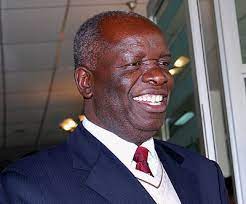
Magande led negotiations for debt forgiveness between 2000 and 2005 Heavily Indebted Poor Countries (HIPC) Initiative
The privatisation of the mines, which started at the end of the 20th century resulted in tremendous benefits to Zambians and achieved incremental copper production. By 2005 copper production had reached just under 500,000 tonnes from 250,000 tonnes in 2000.
As copper prices started to rise, public agitation for the Zambian government to take some action towards collecting more revenue from the mines rose.
The government invited the IMF to send a team of experts to study the situation and make appropriate proposals for a reform of the mining tax regime.
As the Zambian government was enjoying the best of relations with the IMF, it was easy for us to express the government’s expectations from the visiting team.
The three-man team recommended that the government engages the mining companies with a view to amend the current levels of tax as, “the Development Agreements in their current form are lopsided and even if the mining companies were to move to the 2007 tax regime, the country would still not get a share from its mineral resources”.

late Cardinal Medardo Mazombwe
Since the mining companies were suspicious of the role of the IMF team, we shared the study report with them. President Mwanawasa had group meetings with senior officials of the mining companies.
When they made comments, they were all referring to the provisions of the Development Agreements, which they claimed that they cannot be renegotiated. This attitude did not please the legally-minded President.
We then constituted a team made of government officials and traditional leaders (chiefs), which visited mining countries in Southern and West Africa. The Norwegian Government hosted the team and explained their tax system on the crude oil extractive industry.
After a simulation of the application of the various tax numbers by the team, we prepared the Mines and Minerals Development Act 2008, which was presented to and overwhelmingly passed by Parliament in January 2008.
Amongst the landmark new taxes and contributions were:
a windfall tax to be triggered when copper prices reached an unexpected high level; a reference arms-length price, ring-fencing of capital expenditures on new projects; sharing of mining revenues with the local communities from where minerals are extracted;
a formal benefit- sharing framework for mining company contributions to social development of local communities and the creation of a special fund at Bank of Zambia to hold all mining revenues.
All these taxes adding to an average effective rate on mining of 47 percent and contributions were explained by me and ministry officials and accepted by most mining companies.
We were convinced that at last the Zambians would benefit from their God-given mineral resources.
By the end of 2008, the first year of application, the windfall tax account had US $485 million. In 2009, the progressive mining tax regime was revoked by Parliament on the recommendation of the Zambian Government.
To help the determination of mining revenues and taxes, we advocated the membership of Zambia to the Extractive Industries Transparency Initiative (IEII) and the reform of operations of the Zambia Revenue Authority. After some extensive studies, the ZRA established the Mineral Output Statistical Evaluation System (MOSES) to help tracking of copper movements to the markets.
By 2020, copper production by the Zambian mines had gone up to 750,000 tonnes with projections of 850,000 tonnes in 2021. With copper prices around US $10,000 per tonne, Zambia could earn US $8.5 billion in 2021 from exports of copper.
With a windfall tax in place, the Zambian Government would be receiving a substantial amount in taxes during boom times. The high demand on the international market is being stimulated by the phenomenal production of electric vehicles due to development of technology requiring parts made from copper.
It is estimated that production of electric vehicles will rise from 3 million in 2017 to 27 million in 2027, demand for copper for vehicles will be 1.74 million tonnes. More uses of copper are still being discovered, such as the tainting of masks, one of the defences against Covid 19.
There are predictions of a shortage of copper by 2025, when a tonne of copper could be fetching between US $15,000 and US$20,000 per tonne.
With such a viable, profitable and promising industry that has the capability of earning the much-needed foreign currency to enable Zambia to service the huge national external debt and industrialize the economy, there is no rationale for nationalizing the mines this time.
I am aware that the Zambian PF Government started talking of nationalizing the mines in 2020 and has since taken-over the Mopani Mine from Glencore, under a costly and hazy purchase agreement. Konkola Copper Mines has also been affected by the unclear actions of the government, the minority shareholders.
While the nationalization of the nineties was under a clear legal provision and took five years to negotiate, the recent actions on Mopani and Konkola Mines have resulted in loss of confidence in the investor community, at a time when the copper price is rising and Zambia should be a preferred destination for investors.
Is it not anomalous that the same Glencore that has vacated Zambia has just completed a US $8.0 billion investment in the copper and cobalt mines in Kolwezi in the neighbouring Democratic Republic of Congo?
The Government of the Republic of Zambia (GRZ) already owns shares, on behalf of Zambians, in all the mining companies through ZCCM-IH in which it has 77.7% shares. Its relationship with the majority shareholders should be on the basis of friendly, frank, formalized and predictable manner to attract the majority shareholders to invest and grow our mining businesses in Zambia.
These are not the former colonisers, but business persons who want to make money by cooperating with Zambians. Zambia can earn adequate foreign currency from the mines to pay off its current debt and industrialize the economy.
Should any issue, including equitable sharing of the revenues or situation require us to negotiate with the existing or new mining investors, surely the motions that we went through between 1991 and 2003 are enough lessons for us to achieve win-win agreements. The current generation of Zambians should not emulate our ancestors who for thousands of years were only guards of the mineral wealth buried in our rich soils for lack of appropriate technology.
The opening up of Zambia’s mining industry to foreign investors has provided ambitious and adventurous young Zambians an opportunity to work in the international globalised village and to acquire Internet of Things (IoT). A pragmatic plan on how to use Zambia’s abundant agricultural land will lure these Zambians from the Diaspora to invest in modern commercial farming.
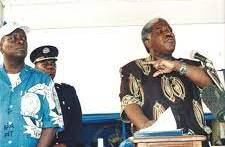
Magande with Mwanawasa
I hope that the Secretary to the Cabinet will tell the new Cabinet, to be formed after 12th August 2021, that nationalizing the mines was done before and it did not work to produce the wealth that Zambians are earning for.
The Secretary to the Cabinet should also tell the new Cabinet, members of parliament and councillors that the current land tenure system and procedures applied on the 73 million hectares of Zambia are not working to the benefit of the Zambians, whether for producing food or estate development. Ngándu Peter Magande














